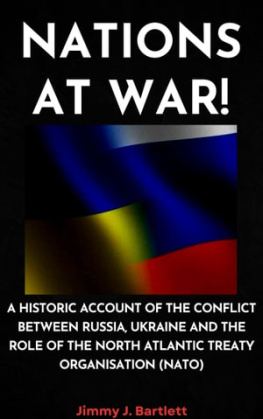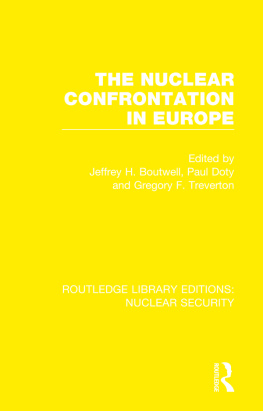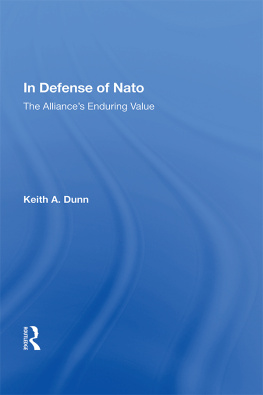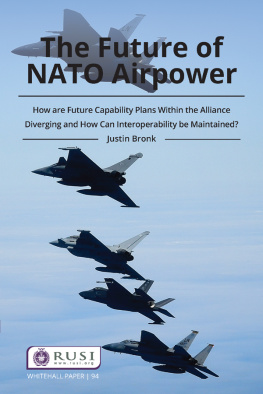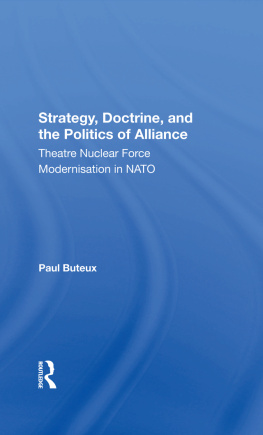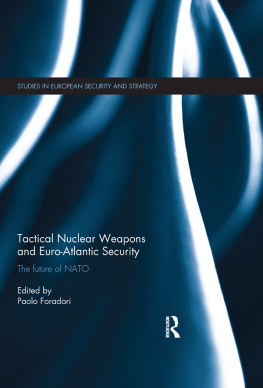Cover
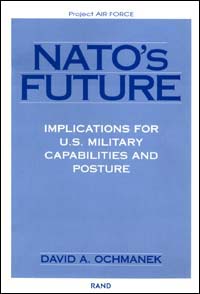
| title | : | NATO's Future : Implications for U.S. Military Capabilities and Postures |
| author | : | Ochmanek, David A. |
| publisher | : | RAND |
| isbn10 | asin | : | 083302809X |
| print isbn13 | : | 9780833028099 |
| ebook isbn13 | : | 9780585383514 |
| language | : | English |
| subject | North Atlantic Treaty Organization, United States--Military policy, Europe--Defenses. |
| publication date | : | 2000 |
| lcc | : | UA646.3.O3 2000eb |
| ddc | : | 355/.031091821 |
| subject | : | North Atlantic Treaty Organization, United States--Military policy, Europe--Defenses. |
Page a
The research reported here was sponsored by the United States Air Force under Contract F49642-96-C-0001. Further information may be obtained from the Strategic Planning Division, Directorate of Plans, Hq USAF.
Library of Congress Cataloging-in-Publication Data
Ochmanek, David A.
NATO's future: implications for U.S. military capabilities and
posture / David A. Ochmanek.
p. cm.
MR-1162-AF.
Includes bibliographical references.
ISBN 0-8330-2809-X
1. North Atlantic Treaty Organization. 2. United
StatesMilitary policy 3. EuropeDefenses. I. Title.
UA646.3 .03 2000
355 .031091821dc21 99-086504
RAND is a nonprofit institution that helps improve policy and decisionmaking through research and analysis. RAND is a registered trademark. RAND's publications do not necessarily reflect the opinions or policies of its research sponsors.
Copyright 2000 RAND
All rights reserved. No part of this book may be reproduced in any form by any electronic or mechanical means (including photocopying, recording, or information storage and retrieval) without permission in writing from RAND.
Published 2000 by RAND
1700 Main Street, P.O. Box 2138, Santa Monica, CA 90407-2138
1333 H St., N.W., Washington, D.C. 20005-4707
RAND URL: http://www.rand.org/
To order RAND documents or to obtain additional information,
contact Distribution Services: Telephone: (310) 451-7002;
Fax: (310) 451-6915; Internet: order@rand.org
Page i
Project AIR FORCE
NATOs
FUTURE
IMPLICATIONS FOR
U.S. MILITARY
CAPABILITIES AND
POSTURE
DAVID A. OCHMANEK
Prepared for the
UNITED STATES AIR FORCE

Approved for public release; distribution unlimited
Page ii
This page intentionally left blank
Page iii
Preface
The 1990s have been a decade of rapid change and adaptation for the North Atlantic Treaty Organization (NATO). As the Cold War came to a close and the Soviet Union collapsed, some called for an end to the alliance that had played a central role in countering Soviet military power for the previous 40 years. Others, impressed with the continuing need for transatlantic security cooperation, called upon NATO to adopt new missions, beyond its traditional role of territorial defense, aimed at meeting fresh security challenges.
Events have shown the need for a transformed NATO capable of undertaking a wide range of missions, including:
- Projecting stability into areas around the periphery of the NATO treaty area
- Intervening effectively in civil conflicts, such as those that have arisen in the former Republic of Yugoslavia
- Coordinating power-projection operations into areas such as the Persian Gulf region
- Countering weapons of mass destruction, both by impeding their proliferation and by preventing the use of such weapons.
An evolving consensus among the allies has led to a significant, if fitful, extension of NATOs mandate to encompass at least the first two of these missions. Over time, this expansion of NATOs area of regard and the scope of its missions is likely to continue, provided the Alliances leading members have the political will to act when called upon to extend their influence outward. The questions that remain relate to the types of military capabilities most needed to make these missions a reality, and the rate and extent to which the United States and its allies are likely to field such capabilities. This report addresses these questions in the context of the Alliances emerging strategy for advancing the interests of its members in peacetime, crisis, and war. It
Page iv
points to the need for a heavy emphasis on enhancing the deployability of NATOs military forces, and it forecasts a growing need for effective defenses against weapons of mass destruction and their means of delivery.
The research summarized here is part of a larger project on the implications of the changing strategic environment in and around Europe and its implications for the United States and NATO. The project, sponsored by the Commander-in-Chief, U.S. Air Forces in Europe, and by the Deputy Chief of Staff for Operations, Headquarters, United States Air Force, was conducted in the Strategy and Doctrine Program of RANDs Project AIR FORCE. This report should be of interest to those engaged in policy toward, or the study of, European security in the postCold War setting. Although its focus is on air forces and military units that can support air operations, its broad conclusions are relevant to all future U.S. and European forces.
PROJECT AIR FORCE
Project AIR FORCE, a division of RAND, is the Air Force federally funded research and development center (FFRDC) for studies and analyses. It provides the Air Force with independent analyses of policy alternatives affecting the development, employment, combat readiness, and support of current and future air and space forces. Research is carried out in four programs: Aerospace Force Development; Manpower, Personnel, and Training; Resource Management; and Strategy and Doctrine.
Page v
Contents
Preface | iii |
Summary | vii |
Acknowledgments | xi |
CHAPTER 1
THE EMERGING SECURITY ENVIRONMENT | |
CHAPTER 2
CHANGING MISSIONS | |
CHAPTER 3
OBJECTIVES AND STRATEGY | |
Shaping | |
Coping | |
Hedging | |
CHAPTER 4
IMPLICATIONS FOR NATOS FORCE PLANNING | |
CHAPTER 5
IMPLICATIONS FOR U.S. FORCE PLANNERS | |
Shaping | |
Coping | |
Hedging | |
CHAPTER 6
SOME THOUGHTS ON U.S. FORCES IN EUROPE | |
CHAPTER 7
THE WAY AHEAD | |
Page vi
This page intentionally left blank
Page vii
Summary
The United States and its allies face a host of challenges in the international sphere, including the looming threats of proliferation, regional conflict, terrorism, and the manifold problems associated with the failure of regimes to meet the needs of their populations. As daunting as these challenges are, veterans of the Cold War will be quick to point out that things could be worse. After all, NATOs member nations no longer face a plausible threat to their survival, as they did throughout the Cold War when Soviet military forces were deployed in the heart of Europe. Although some observers in recent years have bemoaned the loss of certainty and predictability that they (erroneously) think characterized the Cold War geopolitical situation, there should be no nostalgia for a period in which two nations with the power to destroy much of civilization pursued antagonistic security agendas.
Next page


